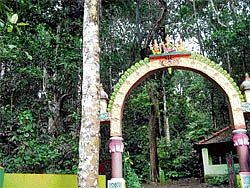

Driving in the Western Ghats during the monsoon is an exhilarating experience - the pleasant weather, puddles and pools of muddy brown water, a medley of bird calls and greenery all around. And then, of course, are pot-hole filled roads. Trying to capture the verdant greenery on camera is near impossible. So we give up, put our cameras aside and sit back to enjoy the sights and sounds of the region during the monsoon. We get glimpses of Shimoga district’s smaller villages and towns as we wait for our destination, Yelakundli devarakadu.
Yelakundli is a small village in Sagar taluk. We weave through the long winding roads.
Paddy fields and ponds alternate. We arrive at the devarakadu at three in the afternoon.
The devarakadu (sacred grove, ‘forest of the gods’) faces a river and is surrounded by paddy fields. The concept is an ancient one, explains the board outside this huge dense forest. The board also states that there are references to the word devarakadu as far back as 321 AD in ‘Aranya Neethi’, one of the many rules or neethis to live an ideal life, described in Kautilya’s ‘Neethi Shastra’. The forest is gated and a small road winds through the thicket. The trees on either side are tall and sturdy.
As we enter, on the right is a small gudi (temple) and at a distance in the front is a bigger temple, dedicated to the deity of Rachamma. The guide who brings us here is not a botanist. So he seeks help from a couple of farmers, Rachappa and Mohan, going home for lunch. Taking great pride in their devarakadu, they put off lunch and spend a good hour walking around the forest with us!
They show us the kind of trees that grow in the kadu, nagasampige, hebbalsu and dhoopa, to name the main ones. The locals don’t use these trees for firewood. They worship the forest deity, Rachamma.
The devarakadu is also called Rachammana kadu, they explain. They occasionally do use the produce fallen on the ground. A fruit of a giant creeper, thoogalike, is edible and given to children as medicine. “It is full of Vitamin A,” enlightens Mohan in English.
As we tread slowly towards goddess Rachamma’s temple, we realise that the path is mossy and slippery. I can see lichens on the trees surrounding the temple.
The temple is just a simple structure with an aluminium sheet roofing over a square room that houses the deity. A string of temple bells adorn its entrance. Beyond the structure is a dense forest. Rachappa explains that people don’t go beyond the temple, which acts as a boundary between human beings and wildlife.
As we look at the vast dense expanse with envy, I question Mohan about the size of the green cover. The board mentions that the kadu covers about 16 acres, but Mohan says it extends much beyond.
The sky gets darker or perhaps the forest is very thick. Our photos get blurry. We also feel guilty that Rachappa and Mohan haven’t yet eaten. We tread back to the entrance, at a faster pace, because it begins to drizzle again.
I then realise that the devarakadu concept still stands today not due to strict rules or regulations of the Forest Department, but because of the loyalty and dedication of the locals. Like Rachappa and Mohan.
Natural sanctuaries
‘Devarakadus’ are natural sanctuaries where the communities don’t cut trees or kill animals. They are often associated with the local deities and are protected by the local communities for generations. Such groves conserve the biodiversity of the region. Sacred groves help in preventing soil erosion, increase the water table and balance the ecology of the region. They are called by many names – ‘devarakadu’ in Karnataka, ‘kovilkaadugal’ in Tamil Nadu, ‘kavu’ in Kerala and ‘deora’, ‘malvan’ and ‘oran’ in Rajasthan. Karnataka is home to a very large number of such sacred groves. Till recently, there were up to 25,000 such sacred groves and eco-systems across the country. They are now rapidly being lost.
(Source: Bangalore Environment Trust)
